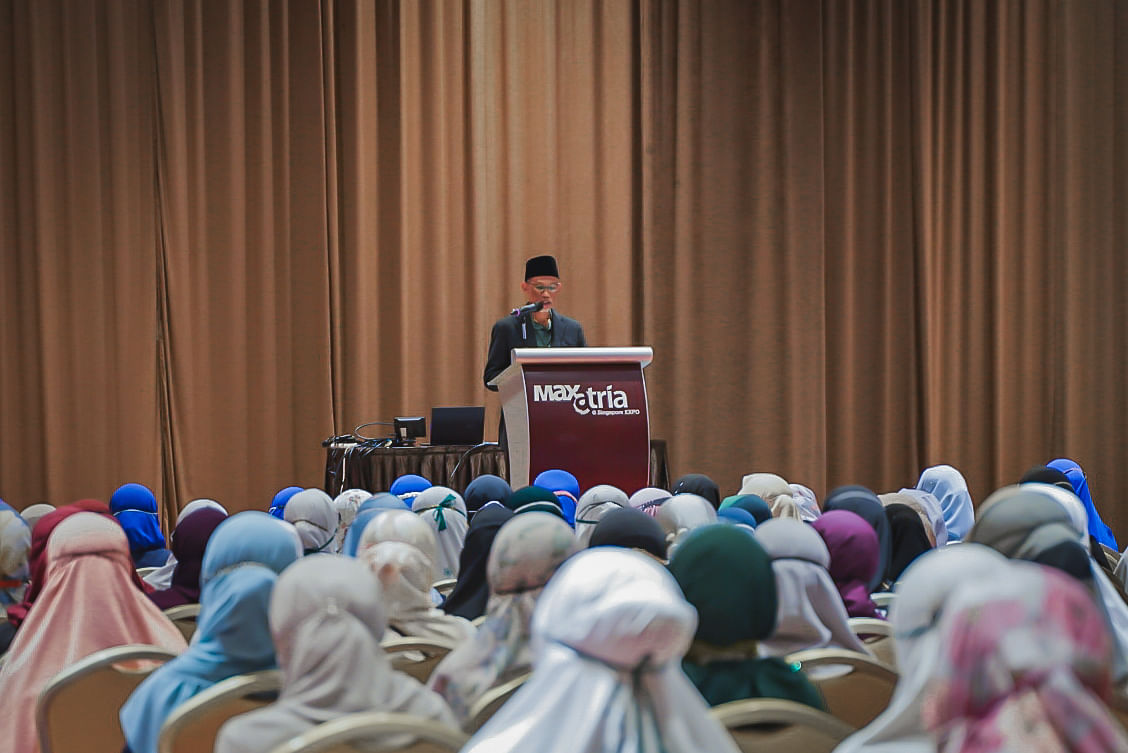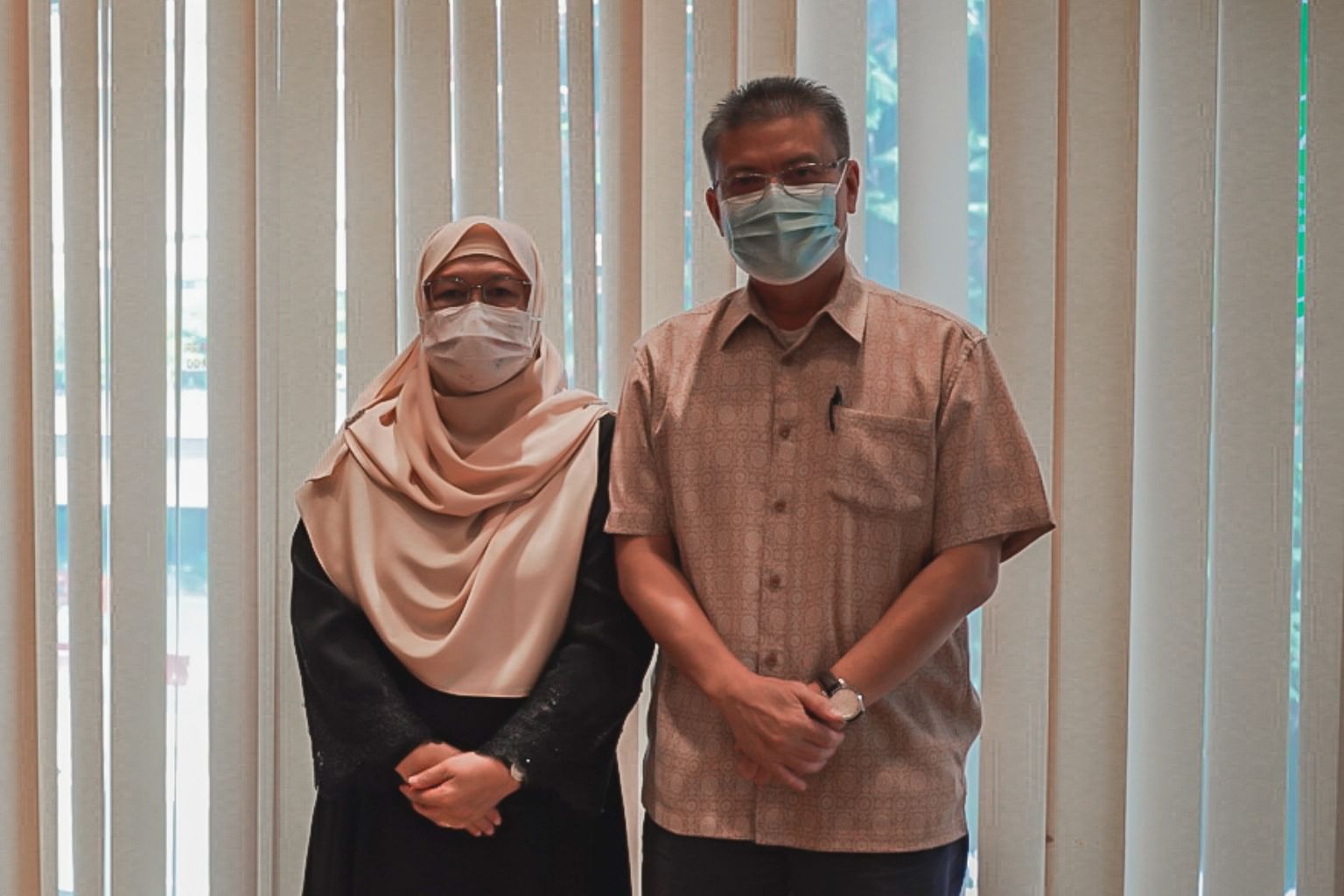App to give S'porean pilgrims access to medical help during haj amid hot Saudi weather, Covid-19
Sign up now: Get ST's newsletters delivered to your inbox

Minister Masagos Zulkifli at the annual haj pre-departure briefing held by Singapore Pilgrims’ Affairs Office.
PHOTO: BERITA HARIAN
Tasneem Begum Mustapha, Elijah Wong
Follow topic:
SINGAPORE - As part of his preparations for the haj, physical education teacher Nur Qarnain has been jogging and cycling weekly. The 52-year-old has even walked 10km from his house in Jurong West to Clementi in his slippers.
Slippers and sandals are needed for the haj as shoes that cover the entire foot and ankles are not allowed when performing certain rituals.
Mr Nur is one of 407 people from Singapore who are travelling to Saudi Arabia for the haj in the coming weeks, the first time Muslims here will be able to go on the pilgrimage since the pandemic hit more than two years ago.
They were at the Singapore Expo on Saturday (June 18) for a pre-departure briefing held by the Association of Muslim Travel Agents Singapore (AMTAS) with the support of Muis.
The haj lasts five days and the trips are undertaken over the period of one month, which this year falls in the summer. The pilgrimage is physically strenuous, with pilgrims walking an estimated 58km over the five days visiting various holy sites for rituals.
Summer in Saudi Arabia can be hot, with temperatures reaching about 42 deg C in Mecca on Friday. Travel agents handling haj trips have also advised pilgrims to reduce close contact with others while performing the haj amid the pandemic.
In response to health concerns, the Islamic Religious Council of Singapore (Muis) will be launching a new app, PilgrimSG, which can locate pilgrims via the Global Positioning System and enable them to get help when they require emergency assistance in Saudi Arabia.
It will also provide them with real-time news alerts relating to safety.
Minister-in-charge of Muslim Affairs Masagos Zulkifli, who is leading Singapore's haj delegation this year, said: "We recognise that health is always an important issue to manage for haj, especially this year. Through this application, we hope to improve access to healthcare services and other relevant information while our pilgrims perform the haj in the Holy Lands."
Although not compulsory, pilgrims are highly encouraged by Muis to install the app.
Also at the briefing were Mr Shahrudin Abdul Samad and his wife Sulija Amat, both 60, who applied to go on the haj in 2012. They were initially notified by Muis in 2019 that they would be going in 2020 but then the pandemic hit.
"We were so worried about whether we could actually go because we're already in our 60s. I wondered if I would ever have the chance to do my haj," said Mr Shahrudin, a senior engineer at PUB.
Madam Sulija, a housewife, recalls being overwhelmed with emotion when she found out that she was able to carry out the haj this year with her husband.
She added: "I started crying, we both just felt so relieved."

To prepare themselves for the physical demands of the haj, the couple have started exercising weekly at the parks.
The pilgrims going this year had all been scheduled to go in 2020.
According to Muis, there are approximately 38,000 Muslims on the waiting list to go on the haj. Muis has said it is working closely with the Saudi authorities for a higher quota for Singapore.
Those chosen to go for the haj this year were selected on a first come, first served basis. Saudi Arabia's Ministry of Hajj and Umrah had earlier said each country would be given approximately 45 per cent of its pre-pandemic quota. Singapore's quota before the pandemic was 900 places.
This year, only pilgrims aged below 65 are allowed to perform the haj, due to health concerns relating to Covid-19. They also need to be vaccinated against the virus with a Saudi-approved vaccine, and must submit a negative polymerase chain reaction test within 72 hours of departure to Saudi Arabia.
Beyond preparing themselves for the physical demands of haj, the journey to haj begins in Singapore for many pilgrims. They attend classes to learn about the do's and don'ts when performing the haj. For instance, they cannot use scented soaps, must not clip their nails and the men must not use sewn clothing, as pilgrims are meant to distance themselves from material distractions.
"I revise what I've learnt in class with my wife, and we've gotten closer chatting about our spiritual journeys that have led us to where we are in life," said Mr Nur.
Mr Sulaiman Mohd Ghazali, 64, and his wife have been saving up for the haj for more than 20 years and were relieved they were called to go this year.
"It's the one chance we have because of the limited quota. This is our life savings. As long as we can go, we will," said Mr Sulaiman, referring to the wait of about 10 to 15 years for Singaporean haj applicants due to the quota system.
Mr Nur visited Saudi Arabia for the umrah - a shorter version of the haj with fewer stations to complete - in 1999 for his honeymoon. This year, he will be going for the haj with his wife.
He said: "We already believed in our hearts that we would be back here for the haj. This will be the highlight of my life as a Muslim."
The haj is one of the five pillars of Islam, and Muslims who are physically and financially able to do so are expected to perform the pilgrimage at least once in their lifetime.
Correction note: An earlier version of this story said that the pre-departure haj briefing was held by the Singapore Pilgrims' Affairs Office. This has been corrected. We are sorry for the error.

